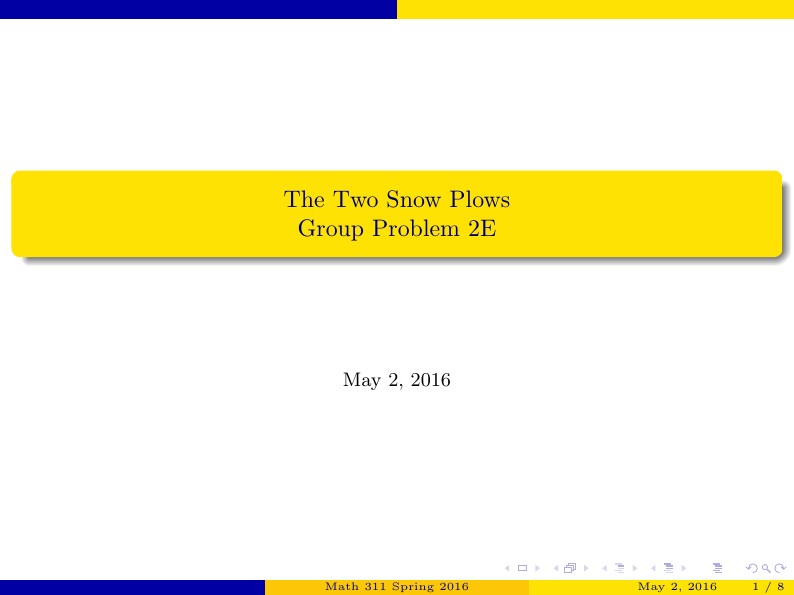
Math 311 Spring 2016
Auteur:
Jason Adkins
Last Updated:
il y a 10 ans
License:
Creative Commons CC BY 4.0
Résumé:
Two Snow Plows Problem

\begin
Discover why over 20 million people worldwide trust Overleaf with their work.
Two Snow Plows Problem

\begin
Discover why over 20 million people worldwide trust Overleaf with their work.
\documentclass[9pt]{beamer}
\usefonttheme{serif}
\usepackage[latin1]{inputenc}
\usepackage{colortbl}
\usepackage{amsmath, amssymb, amsthm}
\usepackage{graphicx}
\usepackage{booktabs}
\usepackage{empheq}
\usepackage{hyperref}
\newtheorem{thm}{Theorem}[section]
\newtheorem{prop}[thm]{Proposition}
\newtheorem{cor}[thm]{Corollary}
\newtheorem{lem}[thm]{Lemma}
\newtheorem{quest}[thm]{Question}
\newtheorem{prob}[thm]{Problem}
\usetheme{CambridgeUS}
\usecolortheme{wolverine}
\title[Math 311 Spring 2016]{The Two Snow Plows\\ Group Problem 2E}
\date{May 2, 2016}
\begin{document}
%--------------------New Frame---------------------------
\begin{frame}
\titlepage
\end{frame}
%--------------------New Frame---------------------------
\AtBeginSubsection[]
{
\begin{frame}<beamer>
\frametitle{Layout}
\tableofcontents[currentsection,currentsubsection]
\end{frame}
}
%\begin{frame}{Agenda}
%Today we will talk about:
%\begin{itemize}
%\pause \item mathematical models
%\pause \item examples
%\end{itemize}
%\end{frame}
\section{Direction Fields}
%--------------------New Frame---------------------------
\begin{frame}{The Problem}
\begin{itemize}
\item[] Suppose it starts snowing at a constant rate at 12:00 pm and two snowplows are to be dispatched to clear a long road from the same garage. If Plow X leaves at 1:00 pm and Plow Y leaves at 2:00 pm, will they collide? If so, when? Assume the snowplows can clear snow at a rate inversely proportional to the depth of snow.\vskip 3mm
\pause \item[] Using information from the problem, we can determine that: \vskip 1mm
\begin{itemize}
\pause \item[a)] The snow is falling at a constant rate $r$, \\
\pause \item[b)] At $t = 1$, Plow X departs, making $x(1) = 0$, \\
\pause \item[c)] At $t = 2$, Plow Y departs, making $y(2) = 0$.
\end{itemize}
\vskip 3mm
\pause \item[] Since the rate of snowfall is constant, we symbolize this with the constant $r$.
\end{itemize}
\end{frame}
%--------------------New Frame---------------------------
\begin{frame}{Setting Up the DEs}
\begin{itemize}
\item[] Since the snowplows can clear at a rate inversely proportional to the depth of snow, we can set up their differential equations:
\pause \item[]\begin{eqnarray*}
\dfrac{dx}{dt}&=&\dfrac{k}{h_x(t)}, \\
\dfrac{dy}{dt}&=&\dfrac{k}{h_y(t)}.
\end{eqnarray*}
\pause \item[] Where
\begin{eqnarray*}
h_x(t) &=& rt, \\
h_y(t) &=& r(t-T), \\
A &=& \dfrac{k}{r}.
\end{eqnarray*}
\pause \item[] Substituting:
\begin{eqnarray*}
\dfrac{dx}{dt}&=&\dfrac{A}{t}, \\
\dfrac{dy}{dt}&=&\dfrac{A}{(t-T)}.
\end{eqnarray*}
\end{itemize}
\end{frame}
%--------------------New Frame---------------------------
\begin{frame}{Solving for $x(t)$}
\begin{itemize}
\pause \item[]
\begin{eqnarray*}
\int \dfrac{dx}{dt} &=& \dfrac{A}{t}, \\
\pause x(t) &=& A\ln|t| + C.
\end{eqnarray*}
\pause \item[] Solving for C using the initial condition $x(1) = 0$:
\begin{eqnarray*}
x(1) = 0 &=& A\ln|1| + C, \\
\pause 0 &=& C.
\end{eqnarray*}
\pause \item[] This yields our position function for Plow X:
\begin{eqnarray*}
x(t) &=& A\ln|t|.
\end{eqnarray*}
\end{itemize}
\end{frame}
%--------------------New Frame---------------------------
\begin{frame}{Solving for $y(t)$}
\begin{itemize}
\pause \item[] Inverting the DE for Plow Y:
\pause \item[] \begin{eqnarray*}
\pause \dfrac{dt}{dy}&=&\dfrac{(t-T)}{A}, \\
\pause B &=& \dfrac{1}{A}.
\end{eqnarray*}
\pause \item[]Solving the linear DE:
\begin{eqnarray*}
\pause \int \dfrac{dt}{dy} &=& \int B(t-T), \\
\pause t(y) &=& e^{By}(D-By).
\end{eqnarray*}
\end{itemize}
\end{frame}
%--------------------New Frame---------------------------
\begin{frame}{Solving for $y(t)$}
\begin{itemize}
\item[] Solving for D using the initial condition $y(2) = 0$:
\begin{eqnarray*}
\pause t(0) = 2 &=& e^{0}(D-0), \\
\pause 2 &=& D.
\end{eqnarray*}
\pause \item[] This yields Plow Y's position function:
\begin{eqnarray*}
t(y) &=& e^{By}(2-By).
\end{eqnarray*}
\end{itemize}
\end{frame}
%--------------------New Frame---------------------------
\begin{frame}{The Collision}
\begin{itemize}
\item[] The plows will collide at time $T$ if:
\begin{eqnarray*}
x(T) &=& y(T), \\
\pause A\ln|T| &=& y(T), \\
\pause T &=& e^{By(T)}.
\end{eqnarray*}
\pause \item[] Solving for $t(y)$ where $t = T$:
\begin{eqnarray*}
T &=& e^{By}(2-By), \\
T &=& T(2-\ln|T|), \\
T &=& e^{1} = e.
\end{eqnarray*}
\pause \item[] Plow Y will collide with Plow X $e$ hours after it begins snowing, or approximately 2:43 PM.
\end{itemize}
\end{frame}
%--------------------New Frame---------------------------
\begin{frame}{The Collision, Part B}
\begin{itemize}
\item[] If Plow Y leaves 2 hours after Plow X instead of 1 hour, will they still collide? \vskip 3mm
\pause \item[] The initial condition changes so that $y(3) = 0$. \vskip 5mm
\pause \item[] Solving for $t(y)$ where $t = T$:
\begin{eqnarray*}
T &=& e^{By}(3-By), \\
T &=& T(3-\ln|T|), \\
T &=& e^{2} = e^2.
\end{eqnarray*}
\pause \item[] Plow Y will collide with Plow X $e^2$ hours after it begins snowing, or approximately 7:23 PM.
\end{itemize}
\end{frame}
\end{document}